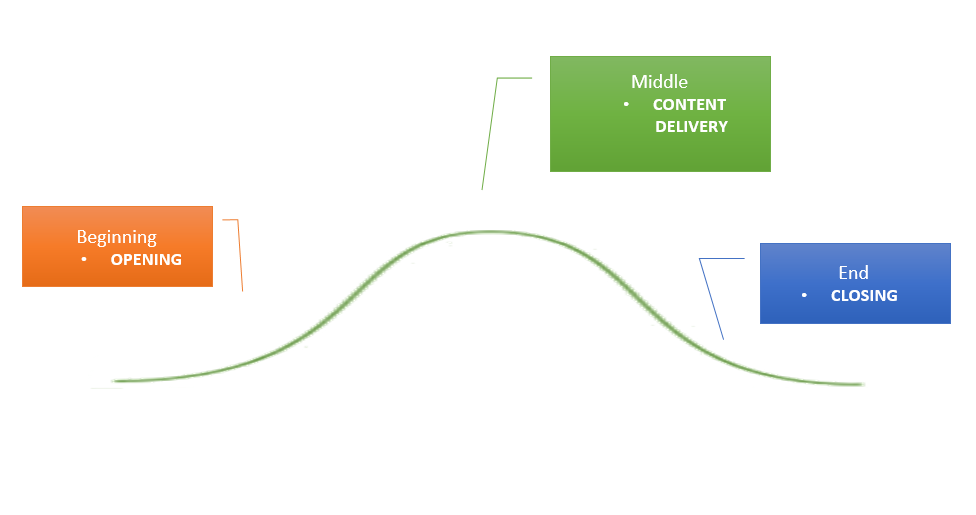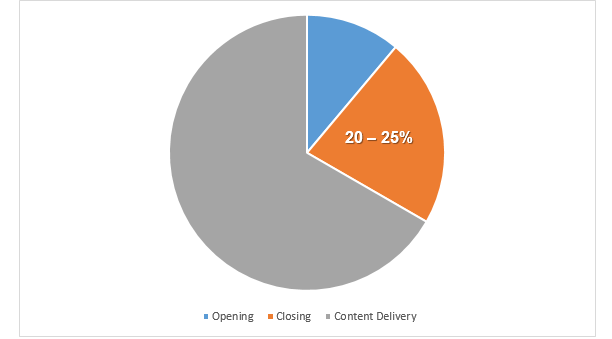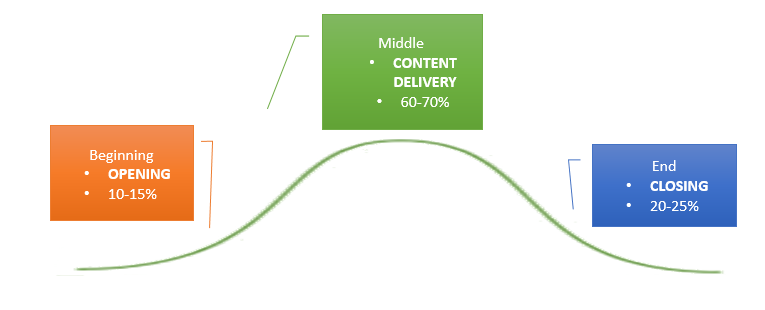3 Components of a Training Plan F19
Writing a training plan is twin to writing a book…it has a beginning, middle and an end…with the trainer being the author, illustrator and the narrator!
The Training Plan has three components or segments: the Opening, Content Delivery and Closing.

In many trainings, the closing section often gets “shortchanged”. Content Delivery also tends to “eat up” more time than it should. It is important to make sure that all components are carefully and concisely planned.
Opening
Let’s look, for a moment, at each component separately. The OPENING “sets the stage” for the training and should use between 10 – 15% of the total workshop timeframe.


The OPENING component of the Training Plan includes the following tasks:
- Welcome (Title of Training)
- Introductions
- Trainer(s) and Participants
- Overview
- Agenda, Preview, and Activate Prior Knowledge activity
- Housekeeping Items
- Establish Ground Rules, Explanation of Resources, and Miscellaneous
The Opening component of the training is where a lot of first impressions are made. It is critical for the trainer to be ready, organized and welcoming. The order of the Opening tasks listed above and in the ?handout (pg. 39) are somewhat flexible. For instance, you may choose to do Housekeeping after the Welcome and then the Overview. That flexibility is up to the trainer.
Content Delivery
The CONTENT DELIVERY component of the training session comprises between 60 – 70% of the total workshop time frame.


The CONTENT DELIVERY component of the Training Plan includes the following tasks (the order is minimally flexible):
- Content
- Exercise
- summary (small ‘s’ – mini-summaries may happen in this component in longer trainings)
This middle segment, where the trainer manages the bulk of the knowledge and skills development, has to be carefully managed so time is spent in both dispensing knowledge about the topic at hand, as well as providing practice exercises that support the new knowledge. Practice opportunities and debriefing that practice takes time, energy and careful planning.
Sequence: Content precedes Exercise and Exercise precedes summary. The repetition of each can vary depending on the length of the training.
A few examples:
- Content, Exercise (1-2 hour training)
- Content, Content, Exercise (2 hour training)
- Content, Exercise, summary, Content, Exercise (3 hour training)
- Content, Content, Exercise, summary, Content, Exercise, summary (more than a 3 hour training)
Closing
The CLOSING component of the training should use between 20 – 25% of the total workshop timeframe.


The CLOSING component of the Training Plan includes the following tasks.
- Questions and Comments
- Summary
- Review of content, Application Activity, and Implementation Plan
- Follow-Up Strategy
- Transfer of Learning strategy for participants and trainer’s plan for post-training follow-up with participants.
- Evaluation
- Housekeeping items
- Final Tasks/Announcements, Next Steps, and *Certificates
*Note: Effective February 2019 paper certificates are no longer required for training offered by a credentialed trainer who enters their own data into ECE-TRIS. As a reminder, credentialed trainers must submit their data into ECE- TRIS within 10 calendar days.
The Closing component of the training is where some of your lasting impressions might be made. Like the opening, it is critical for the trainer to be ready, organized and energized. If you fizzle toward the end, guaranteed, your participants will, too! However, if you stay excited about your topic and energized about the work to be completed, chances are, most of your participants will hang in there with you, leaving energized and with a positive outlook toward implementation! That is exactly what you want and you are the one that can best promote that kind of closure! The order of the Closing tasks are also somewhat flexible.
Training Plan Components and PACES™


This visual shows you where PACES™ fits in with the components of the training plan.
